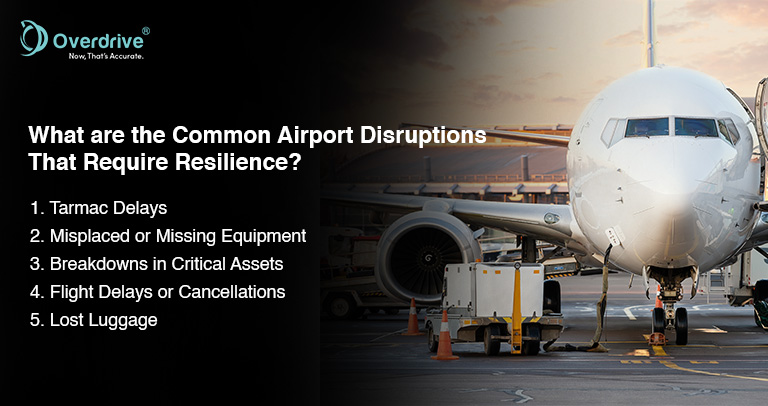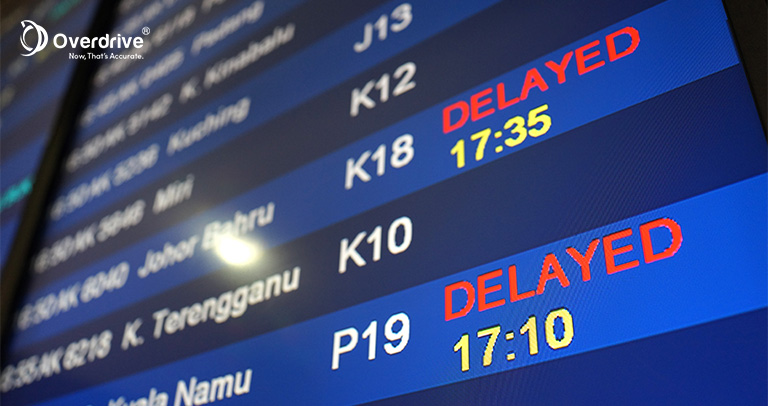Building a Resilient Airport: How Asset Tracking Supports Crisis and Contingency Planning
![]()
Introduction
Modern airports are intricate, high-stakes operations that keep global travel and trade in motion. As worldwide airport investments are projected to hit USD 2.4 trillion by 2040, the pressure to future-proof operations against climate threats, operational disruptions, and system failures has never been greater.
Today’s airports face a delicate balancing act: maintaining operational efficiency while bolstering their ability to respond to unforeseen events. From equipment breakdowns to security threats, even minor disruptions can cascade across departments, grounding flights and jeopardising safety.
Given the fast-moving and interconnected nature of the airport environment, resilience has become an operational necessity. Asset-tracking technology plays a significant part in achieving this. By providing real-time oversight, automating processes, and offering actionable insights, asset tracking empowers airports to detect potential issues early and bounce back quickly from unexpected disruptions.
This article explores how asset-tracking systems enhance airport infrastructure resilience and real-time asset visibility. Join us as we uncover their role in supporting airport operations with greater agility and reliability.
Key Takeaways:
-
What Does Resilience Mean in Airport Operations?
It refers to an airport’s ability to endure, adapt to, and recover from disruptions while maintaining its critical functions.
-
Why is Resilience Important in Modern Aviation?
This is because airports are a critical infrastructure. They rely on a web of supporting infrastructure to ensure functionality. Any disruption in one area can significantly impact overall airport performance.
-
What are Some Common Airport Disruptions?
-
- Tarmac delays
- Misplaced or missing equipment
- Breakdowns in critical assets
- Flight delays or cancellations
- Lost luggage
-
What Does Asset Tracking Mean?
Asset tracking refers to the process of monitoring the real-time location, status, and movement of physical assets. It aims to enhance visibility, reduce delays, and optimise resource allocation.
-
Which Asset Tracking Technology Does the Airport Deploy?
-
- BLE (Bluetooth Low Energy)
- RFID (Radio Frequency Identification)
- GPS (Global Positioning System)
- LoRa (Long Range)
The Role of Resilience in Airport Operations
What Is Resilience in Airport Operations?
Before diving right into the role of asset-tracking technology, we will first need to understand the meaning of resilience in airport operations. It refers to an airport’s ability to endure, adapt to, and recover from disruptions while maintaining its critical functions. Even in the face of natural disasters, technical failures, or security incidents, a resilient airport can maintain operations, safeguarding passengers and staff, and minimising disruptions.
Why Does Resilience Matter in Modern Aviation?
As air travel becomes increasingly integral to global connectivity, the role of airports has expanded far beyond transportation. This makes resilience the key to maintaining operational continuity. So, why is building resilience into airport infrastructure more important than ever? Keep reading for more insights:
1. Airports as Critical Infrastructure
Apart from transit points, airports are also vital economic engines and emergency response hubs. Disruptions can paralyse supply chains, impact tourism, and hinder emergency efforts. Without prompt intervention, ripple effects may spread across entire regions or nations.
2. Interconnected Systems
Modern airports rely on a web of supporting infrastructure, including electricity, telecommunications, water supply, and transport links. A breakdown in any of these areas may severely compromise airport functionality. To mitigate these risks, IoT sensors become a key component in monitoring critical systems in real time, detecting anomalies early, and triggering automated alerts.
3. Disaster Response Hubs
Airports serve as lifelines during emergencies, facilitating the rapid movement of medical supplies, food, and rescue personnel. Their ability to function during and after climate-related disasters or public health emergencies is essential to coordinated national and international response efforts.
![]()
What are the Common Airport Disruptions That Require Resilience?
After understanding why resilience is vital in modern aviation, it’s important to look at the real-world scenarios that put this resilience to the test. Airports operate in dynamic environments where even minor disruptions can escalate quickly. Now, let’s examine some of the most common operational challenges that require strong resilience measures:

1. Tarmac Delays
These often stem from severe weather conditions, unavailable gates, or malfunctioning equipment. Such delays not only inconvenience passengers but also potentially cause cascading schedule disruptions across the airport network.
2. Misplaced or Missing Equipment
Ground handling relies heavily on the timely availability of items like tugs, dollies, and baggage carts. When these go missing, aircraft turnaround times are affected, increasing delays and operational inefficiencies.
3. Breakdowns in Critical Assets
When failure occurs, key operational assets, such as ground service vehicles, must be continuously monitored and quickly repaired or replaced. By doing so, operational standstills become avoidable.
4. Flight Delays or Cancellations
Often stemming from technical issues, air traffic congestion, or weather, delays and cancellations can disrupt the flow of passengers and aircraft. Common problems include missed connections and increased expenses.

5. Lost Luggage
Mishandled baggage is a common issue that strains ground staff and impacts passenger satisfaction. Quick emergency response coordination, identification, and resolution should be performed to maintain service quality and trust.

How to Build Airport Resilience?
Having explored the common disruptions that challenge airport operations, the next step is understanding how airports can strengthen their ability to cope. They must evolve from reactive problem-solving to anticipatory strategies that facilitate swift responses.
1. Adaptation Over Avoidance
Disruptions are inevitable in aviation. Rather than trying to prevent every possible issue, resilient airports focus on adapting to change. This involves investing in flexible airport management solutions, training staff for dynamic responses, and using data-driven insights to guide rapid decision-making.
2. Revenue Impacts
The financial health of an airport is directly tied to passenger volumes and cargo throughput. When disruptions occur—be it pandemics, weather events, or geopolitical shifts—revenue can be hit hard. Resilient airports adopt flexible business models and diversify revenue streams to better absorb economic shocks and maintain operations.
3. Contingency Planning
Operational resilience requires thorough contingency planning. Airports must account for demand fluctuations, supply chain disruptions, and resource constraints. Strategies such as scenario planning, emergency drills, and cost-control frameworks help ensure continuity and speed up recovery during unexpected downturns.
![]()
The Role of Asset Tracking in Crisis and Contingency Planning
What Is Asset Tracking?
To build true resilience, airports must go beyond high-level strategies and invest in tools that provide real-time operational control. In times of crisis, having visibility into the location and condition of critical resources can make the difference between a swift recovery and prolonged disruption. This is where asset-tracking technology becomes a key enabler.
Asset tracking is the process of monitoring the real-time location, status, and movement of physical assets to enhance visibility, reduce delays, and optimise resource allocation. In the context of airport operations, this capability is indispensable for both daily efficiency and crisis management.
By knowing exactly where assets are and what condition they’re in, airports can make informed decisions that prevent bottlenecks. Asset tracking also streamlines operational risk management in aviation, ensuring rapid responses to weather-related delays, equipment failures, or emergency situations.
So, what does asset-tracking technology monitor in general? Take a look at the following types:
1. Powered Assets
These include essential ground support vehicles and machinery, such as:
- Aircraft tow tractors
- Fuel trucks
- Ground power units (GPUs)
- Service vans and maintenance vehicles
- Baggage tugs
Tracking these assets ensures that critical operations like aircraft refuelling, towing, and onboard servicing are carried out without avoidable delays or duplication.
2. Non-Powered Assets
These are often high in volume and prone to misplacement, including:
- Baggage carts
- Mobile staircases
- Container dollies
- Cargo pallets
Although they don’t operate on their own, non-powered assets are still essential for smooth ground handling. Real-time tracking helps reduce search time, prevent asset hoarding, and ensure proper distribution across terminals.
What are the Common Asset Tracking Technologies in Airports?
Each airport asset comes with varying levels of mobility, value, and usage. To effectively monitor different assets, it is necessary to deploy diverse asset-tracking technologies. These solutions work individually or in combination to provide a layered tracking system:
![]()
1. BLE (Bluetooth Low Energy)
BLE is best suited for tracking short-range, non-powered assets such as baggage trolleys, handheld tools, or pushback bars. Its low energy consumption allows for long battery life in small devices, making it a cost-effective option for dense terminal environments.
2. RFID (Radio Frequency Identification)
You may often see RFID tags used in baggage handling systems and warehouse inventory. They can store data and be read without line of sight, enabling fast, automated tracking of high-volume items. Passive RFID is ideal for bag tags, while active RFID may be deployed for cargo containers and crates that require longer-range tracking.
3. GPS (Global Positioning System)
GPS is a key technology for tracking powered vehicles such as fuel trucks, aircraft tow tractors, and maintenance vans. With wide-area coverage and real-time data transmission, GPS enables airport operations teams to facilitate airport ground support equipment tracking, dispatch resources efficiently, and prevent unnecessary idling or misallocation.

4. LoRa (Long Range)
LoRa technology supports low-power, long-distance communication. This asset-tracking solution is deployable across vast airport areas, such as runways, hangars, and remote storage zones. It’s especially effective for non-powered assets that are often relocated over large distances.
How Asset Tracking Enhances Crisis Response
In high-pressure situations, speed and clarity are non-negotiable. Asset-tracking technologies provide real-time visibility and actionable insights, empowering airport teams to respond swiftly and effectively.
Here’s how these systems directly support crisis response and recovery:
1. Instant Access to Critical Assets
During emergencies like aircraft malfunctions, severe weather events, or runway closures, every second counts. Asset tracking enables operations teams to instantly locate emergency vehicles, fire trucks, ground support equipment, and medical units. After confirming their presence, the technology delegates them to the right place without delay. This reduces response time, helps contain disruptions, and supports passenger safety.
2. Smart Resource Reallocation
Crises often create sudden shifts in demand across airport zones. With live data on asset locations and availability, airports can quickly reassign resources to where they are most needed. For instance, asset tracking works in tandem with IoT platform solutions to reroute vehicles for diverted flights, keeping operations fluid even under strain.
3. Controlled Access in Restricted Zones
In the event of a security breach or temporary lockdown, geofencing and location-based tracking offer an added layer of protection. Airports can monitor movement in real time, restrict access to sensitive airside areas, and enforce safety perimeters. Alerts can be triggered if an asset enters or exits a designated zone, helping to prevent unauthorised access and maintain compliance with safety protocols.
How Does Data-Driven Contingency Planning Work?
Modern airports generate vast amounts of operational data daily, from ground equipment logs to vehicle movements and terminal activity. When harnessed effectively, this data becomes a strategic asset for contingency planning. Future-proofing airport operations with data-driven planning is key to strengthening overall resilience.

1. Identify Operational Gaps Before They Escalate
Advanced data analytics allows airports to identify hidden inefficiencies before they cause widespread disruption. By analysing historical usage trends, operators can detect bottlenecks, underperforming zones, or recurring issues across terminals. These insights, often enabled by IoT solutions for airport management, help optimise resource allocation and guide timely interventions.
2. Scenario Simulation for Preparedness
With digital modelling and simulation tools, airports can prepare for various “what-if” scenarios. For example, fuel truck shortages that happen during peak hours. Powered by integrated IoT platforms, these simulations allow teams to test and refine response protocols in a virtual environment. This virtual training is aimed at speeding up coordinated action in real-life crises.
3. Enable Predictive Maintenance
Predictive maintenance for airport equipment is a key element in reducing unplanned downtime and extending asset lifespan. By continuously monitoring usage patterns, mechanical stress, and other performance indicators, IoT-enabled systems can alert teams before equipment fails. This proactive approach ensures critical assets are serviced at the right time, avoiding costly disruptions and maintaining operational continuity.
Frequently Asked Questions
1. How is asset tracking integrated into existing airport systems?
IoT companies like Overdrive allow users to integrate their modern asset-tracking platforms with existing airport management systems. They support multi-network connectivity (BLE, LoRa, GPS, RFID) and offer real-time data that enhances coordination across departments.
2. What are the long-term benefits of asset tracking for airport operations?
Asset tracking boosts efficiency, reduces operational costs, improves safety, and enhances the passenger experience. It also enables data-driven planning, supports regulatory compliance, and future-proofs airport infrastructure.
3. What happens if connectivity is disrupted during a crisis?
Reliable asset tracking platforms use multi-network connectivity, including 2G/3G/4G, LoRa, BLE, and RFID, to ensure continuous data flow. Some systems can also cache data locally and sync once the connection is restored.
Conclusion
Maintaining smooth airport operations in the face of disruptions requires more than reactive solutions. It starts with having full, real-time visibility into where your assets are, how they’re performing, and whether they’re ready for deployment. This operational clarity allows airports to move quickly and maintain service levels even under stress.
Asset tracking plays a pivotal role in this effort. It’s not merely a technology upgrade. By integrating location intelligence, predictive maintenance, and automated alerts into your infrastructure, you equip your airport to respond faster and operate with greater agility.
At Overdrive, we specialise in delivering scalable IoT solutions for airport management. As a trusted IoT company in Singapore, we help organisations turn complexity into control.
Contact us< and learn how smart tracking technologies can strengthen your contingency planning from the ground up.



